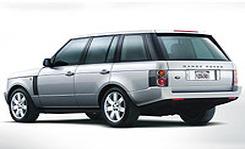When BMW owned Rover of Britain, Wolfgang Reitzle was No. 2 in the German parent company. His priority for the British subsidiary was the development of an all-new Range Rover, a vehicle that would combine the height of luxury with supreme cross-country ability: a German’s idea of the perfect car for an English gentleman.
This new Range Rover was nearly ready when BMW disposed of both Reitzle and Rover. In 2000, by a curious twist of fate, Land Rover became part of Ford’s Premier Automotive Group–which today is run by Wolfgang Reitzle. So he got his pet project back, and sent it into production for the second time.
So this is BMW’s Range Rover, which will be sold, beginning in May, by Ford-owned Land Rover. It differs only in small details from the prototypes that Reitzle masterminded. The engines and many other components come from BMW, which has agreed to supply them for the life of the model.
BMW played it safe with the design. The new Range Rover cannot be mistaken for anything else. It takes its styling cues from the first Range Rover, introduced in Britain back in 1970, rather than the second version that appeared in 1994. The chosen shape was developed in the Land Rover studio at Gaydon, England.
For most of its 31 years, the Range Rover has stood at the top of the hill as the most accomplished, most expensive off-roader. But the Mercedes M-class and BMW’s own X5 presented a serious challenge, and now there is the prospect of the high-performance Porsche Cayenne.
As for these rivals, the emphasis for the new Range Rover is on improving its on-road handling, smoothness, performance, and comfort–but without losing its off-road talents. Land Rover CEO Bob Dover, a usually modest man who once was chief of Aston Martin, boasts: “We believe the new Range Rover is the world’s most capable vehicle, with the greatest breadth of ability of any vehicle ever made.”
Land Rover wants us to see its new flagship as an alternative to luxury sedans such as the Mercedes S-class and BMW 7-series. It became clear early in the development that a target of 20-percent improvement in on-road behavior could only be reached by ditching the beam axles and fitting independent suspensions front and rear, with rack-and-pinion steering. The need for a stiffer structure on which to mount these and the quest for better refinement led to a new unit body instead of the traditional Land Rover body-on-frame construction.
As in the previous model, air springs are used. They provide self-leveling and allow the ride height to be changed over a 3.7-inch range: higher for the rough stuff, lower for freeways, and lower still for easy passenger entrance and exit. New cross-links between the air springs are added with valves that open to effectively soften the suspension when sensors detect (by height and wheel movement) that the driver has ventured off-road.
The classic Land Rover permanent four-wheel-drive system now incorporates a Torsen center differential, and low-range gearing can be selected on the fly. Happily, the ancient Rover V-8 engine is replaced by a BMW V-8 along with a ZF 5HP24 five-speed automatic transmission with BMW’s Steptronic manual override.
The motor–it’s the only one available in the U.S., although there’s also a diesel in Europe–is the 4.4-liter from the BMW X5 rather than the latest Valvetronic launched with the new 7-series. Its 282 horsepower represents a 27-percent power hike from that of the 4.6-liter pushrod Rover engine. BMW supplies the engine to a unique Land Rover specification: Its lubrication system has to be able to cope with 45-degree inclines; mountings and intakes are different; and the electronic throttle has two modes, providing longer pedal travel for off-roading.
This is the first Land Rover to have the latest in automotive electronics. It has Dynamic Stability Control, developed with Bosch and incorporating ABS, four-wheel traction control, corner brake control, brake assist, and Hill Descent Control. The ABS and the traction control work to different parameters off-road.


Leave a Reply